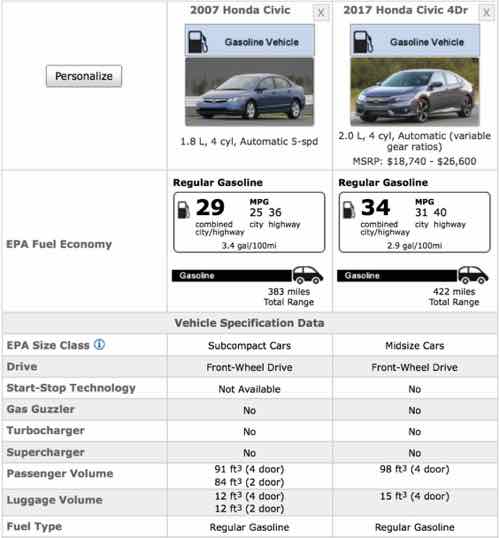Readers: Do Not Ease Future Emissions & Fuel Economy Regulations
Our vehicles are getting bigger, but they use less fuel than just a few years ago. How is this possible? Because of fuel economy regulations manufacturers are making cars lighter, engines more efficient.
Though cars shrank in the 70s & 80s, they’ve been growing again:
Technological progress in the automobile has come with certain tradeoffs, one being an increase in size. Perhaps cars have inflated in size to better fit their occupants. Anyone who’s ridden three across in the back seat of a 1990s compact knows what we’re talking about. Safety standards and packaging even more airbags into each car have also contributed to the growth of the modern automobile.
The EPA places cars into specific size classes from minicompact (less than 85 cubic feet) to large (120 or more cubic feet) based on the combination of passenger and cargo volume. In the interest of consistency, all volume figures quoted are from the EPA. (Motor Trend)
Our 2007 Honda Civic is a prime example. A new Civic has more interior volume yet has a higher fuel rating from the EPA:

The even larger 2017 Honda Accord has a higher EPA rating than our 10 year-old Civic. The “small” 2017 Honda Fit has more interior volume that our Civic — also more than a 1992 Accord! Better fuel economy too — 22 combined for the ’92 Accord but 36 for the new Fit. Worldwide regulations have pushed manufacturers to make cars better.
In March President Trump expressed an interest in slowing down coming regulations:
Originally, regulators mandated that automakers achieve an average 54.5 mpg by 2025, but they relaxed that target to between 50.8 mpg and 52.6 mpg last year. Now, automakers will have more time to fight the standards, as the review process could take about a year.
The review is not set to impact California’s right to impose fuel economy rules that are stricter than federal standards, a White House official told Reuters. However, the official wouldn’t rule out the possibility of that changing in the future. (Motor Trend)
A proposed budget would render any review mute — from last month:
The Trump administration would virtually eliminate federal funding for the Environmental Protection Agency’s budget for vehicle emissions and fuel economy testing but will seek to raise fees on industry to pay for some testing, a government document shows.
The cuts would slash by more than half the staff of the EPA department that conducts vehicle, engine, and fuel testing to verify emissions standards are met and mileage stickers are accurate. Its work helped lead to Volkswagen AG’s (VOWG_p.DE) 2015 admission that it violated vehicle emissions rules for years. (Reuters)
California isn’t backing down on emissions regulations to cut smog, from March:
California will move forward with vehicle pollution targets set forth by the Obama administration, despite a move by current President Donald Trump to put those targets on hold.
On Friday, the California Air Resources Board voted to uphold Obama’s stricter emissions rules for the state. It also established a target for 15 percent of new vehicles to be powered by battery, fuel cell, or plug-in hybrid powertrains by 2025, up from about 3 percent today. The rules are part of CARB’s larger plan to bring greenhouse gas emissions down to 1990 levels by 2030. (Motor Trend)
Don’t be surprised if the Trump administration tries to take away California’s right to set their own auto emissions standards.
Most of those who voted in the most recent non-scientific Sunday Poll agree regulations shouldn’t be eased:
Q: Agree or disagree: With falling gas prices & buyer preference for bigger vehicles, upcoming stricter emissions/fuel economy regs should be relaxed
- Strongly agree 2 [5.56%]
- Agree 3 [8.33%]
- Somewhat agree 0 [0%]
- Neither agree or disagree 0 [0%]
- Somewhat disagree 1 [2.78%]
- Disagree 4 [11.11%]
- Strongly disagree 26 [72.22%]
- Unsure/No Answer 0 [0%]
b
b
b